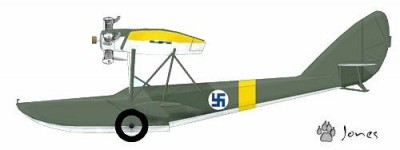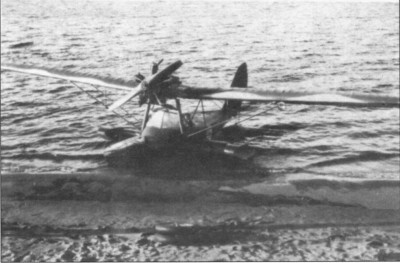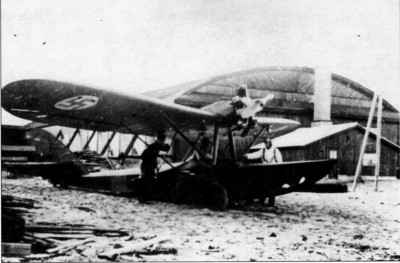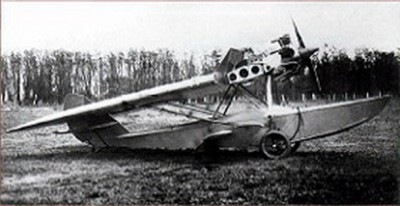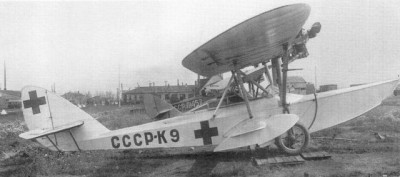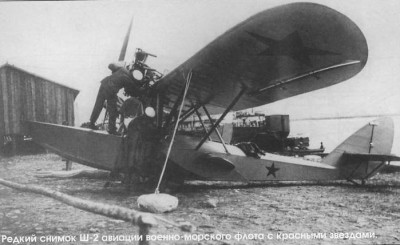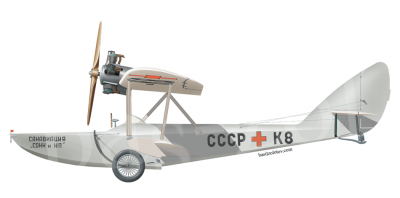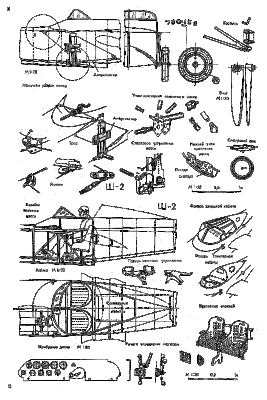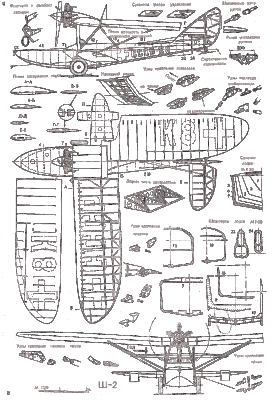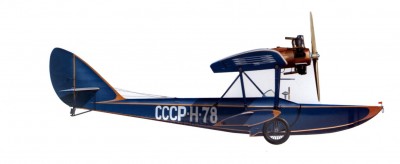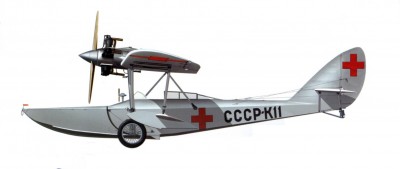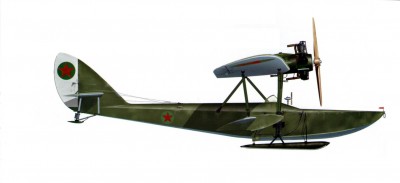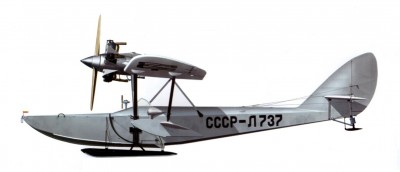| Název: Name: | Šavrov Š-2 | Shavrov Sh-2 |
| Originální název: Original Name: | Шавров Ш-2 | |
| Kategorie: Category: | víceúčelový letoun | utility aeroplane |
| Výrobce: Producer: | DD.MM.1930-DD.MM.1930 Leningradský letecký závod č. 23, Leningrad DD.MM.1932-DD.MM.1934 Taganrožský letecký závod č. 31, Taganrog DD.MM.1940-DD.MM.1941 Leningradské letecké opravárenské dílny GVF, Leningrad DD.MM.194R-DD.MM.1952 Letecká opravárenská základna č. 79, Irkutsk | |
| Období výroby: Production Period: | DD.MM.1930-DD.MM.1952 | |
| Vyrobeno kusů: Number of Produced: | cca 700 | |
| První vzlet: Maiden Flight: | 11.11.1930 | |
| Osádka: Crew: | 3 | |
| Základní charakteristika: Basic Characteristics: | ||
| Vzlet a přistání: Take-off and Landing: | CTOL - konvenční vzlet a přistání | CTOL - conventional take-off and landing |
| Uspořádání křídla: Arrangement of Wing: | dvouplošník | biplane |
| Uspořádání letounu: Aircraft Concept: | klasické | conventional |
| Podvozek: Undercarriage: | zatahovací | retractable |
| Přistávací zařízení: Landing Gear: | obojživelné | amphibious |
| Technické údaje: Technical Data: | ||
| Hmotnost prázdného letounu: Empty Weight: | 660 kg | 1455 lb |
| Vzletová hmotnost: Take-off Weight: | 937 kg | 2066 lb |
| Maximální vzletová hmotnost: Maximum Take-off Weight: | 1160 kg | 2557 lb |
| Rozpětí: Wingspan: | 13,00 m | 42ft 7,81in |
| Délka: Length: | 8,20 m | 26ft 10,82in |
| Výška: Height: | 2,50 m | 8ft 2,43in |
| Plocha křídla: Wing Area: | 24,70 m2 | 265.87 ft2 |
| Plošné zatížení: Wing Loading: | 38 kg/m2 | 7.78 lb/ft2 |
| Pohon: Propulsion: | ||
| Kategorie: Category: | pístový | piston |
| Počet motorů: Number of Engines: | 1 | |
| Typ: Type: | Švecov M-11 o výkonu 74 kW/100 k dvoulistá dřevěná vrtule | Shvetsov M-11, power 99 hp two-bladed wooden propeller |
| Objem palivových nádrží: Fuel Tank Capacity: | 87 litrov | 87 liter |
| Výkony: Performance: | ||
| Maximální rychlost: Maximum Speed: | 139 km/h v 0 m | 86.4 mph in 0 ft |
| Cestovní rychlost: Cruise Speed: | 120 km/h v 500 m | 74.6 mph in 1640 ft |
| Rychlost stoupání: Climb Rate: | ? m/s | ? ft/min |
| Čas výstupu na výšku: Time to Climb to: | 8,3 min do 1000 m | 8,3 min to 3281 ft |
| Operační dostup: Service Ceiling: | 3350 m | 10991 ft |
| Dolet: Range: | 450 km | 279.6 mi |
| Maximální dolet: Maximum Range: | 1300 km | 807.8 mi |
| Výzbroj: Armament: | bez výzbroje | no armament |
| Uživatelské státy: User States: | | |
| Poznámka: Note: | - niektoré technické údaje (vzletová hmotnosť, dostup, dolet) sa mierne líšia podľa závodov, v ktorých boli jednotlivé lietadlá vyrobené | - Some technical data (takeoff weight, service ceiling, range) differ slightly according to the plant, in which the individual aircraft manufactured |
| Zdroje: Sources: | Šavrov, V.B.: Istorija konstrucij samolotov v SSSR 1938-50, Mašinostrojenije, 1988 Němeček, Václav: Šavrov Š-2, Letectví+Kosmonautika, 1978, č. 22, str. 868 Maslov, M.: Amfibija Š-2 i drugije samoljoty Vadima Šavrova, Cejchgauz, Moskva 2008, ISBN 978-5-9771-0063-2 | |
Šavrov Š-2
Shavrov Sh-2
Шавров Ш-2
Savrov S-2
- probably the longest serving type of aircraft in the Soviet Union
The aircraft was constructed by Vadim Borisovič Šavrov as a continuation of the development of the type Š-1. The concept of the aircraft has not changed compared to its predecessor. Only the area of the upper wing was enlarged and a more powerful engine of domestic production was mounted M-11 with a power of 100 hp ( 73.5 kW). In contrast to the Š-1, the canopy of the upper wing had a duralumin skeleton, but the outer parts were again all wooden, covered with canvas. The prototype S-2 was built in the Leningrad plant Krasny Ljotchik and November 11, 1930 was flown to start on wheels. Three days later, however, he was damaged in bad weather while trying to start from the water level of the Neva River. After the necessary repairs, he successfully passed state exams and was accepted into series production.
"Šavrušky", as Š-2 was familiarly called by all who came in contact with them, served mainly for the training of civilian naval pilots. A number of machines worked in lake and sea fishing areas, where he guided fishermen to flocks of fish or seals. Thanks to the possibility of folding the upper wings, the Š-2 also carried icebreakers Krasin, Čeljuskin and Litke on their decks, where they served in the anti-glacier survey. They were used as postal and passenger aircraft, in guarding forests against forest fires, in the Arctic areas in transport to inaccessible places, etc. The machine, piloted by pilot Babushkin, became famous during the rescue of members of the crew of the icebreaker Chelyuskin, whose ship was crushed by ice floes.
Officially, the Š-2 ceased mass production in 1934, but the demand for it was so great that production resumed in 1939. Not in the state aviation industry, but in civil aviation repair shops, as the simple production technology enabled its production even in less equipped workshops. In 1951, the Š-2 underwent modernization. A more powerful engine was mounted M-11 with an output of up to 115 hp (84.5 kW), mounted only one. The equipment was given to start the engine from the cabin with compressed air. Trimmers were mounted on the elevators, controlled by the pilot in flight. Since 1952, a plexiglass cab cover has been fitted to improve crew comfort. Officially, the "sabrušky" were in service until 1964, but there is evidence that flying specimens were seen on the Ob and Yenisei rivers in the 1970s.
Technical description:
Technically, the Š-2 was a single-plane amphibian, an aircraft capable of takeoff and landing from water and the ground, with a hull in the shape of a boat. It was powered by a star-air-cooled engine of Soviet production M-11 with an output of 100 hp (73.5 kW) , which spun a solid wooden propeller with a diameter of 2.35 m. The engine was placed as a towing on the leading edge of the upper wing, which was attached above the fuselage by beams of steel tubes. The lower self-supporting wing was placed almost on the line of immersion of the fuselage, and included side balancing floats. The upper wings could be folded back.
The fuselage was divided by partitions into five watertight compartments, in one of them located under the centerplane of the wing was located an open cabin, covered at the front with a plexiglass windshield. In the cabin, two seats were placed next to each other, with the pilot sitting on the left side (in the direction of flight) and either the student pilot or the flight engineer sitting on the right. Behind them was a third seat on which the passenger sat. Sixteen pieces of this type were made for the medical service, in which the space of the rear seat was replaced by a structure for storing a stretcher with a lying patient. The space thus created was covered with a hinged plywood cover, on which small translucent windows were placed on the side. A small hole was placed in the front of the cover for the doctor's contact with the patient during the flight.
The steering was double with a cable guide from the control levers to the rudders.The structure of the aircraft was for the most part wooden covered with canvas, only the centerplane was lined with duralumin sheets to protect the cover and the structure of the wing from hot exhaust gases.
The chassis consisted of two chassis legs suspended by bundles of rubber ropes, bicycle-type wheel discs were mostly uncovered. Instead of wheels, it was possible to mount skis specially designed for this type in the winter months. Lifting and extending the chassis was performed by turning the crank located in the middle of the dashboard. Chassis legs with wheels or skis were moved by ropes along curved rails located on the outside of the hull plating and secured in the upper or lower position. In the case of landing on water, the lowered landing gear significantly shortened the length of the runway.
Aircraft manufactured after 1951 were equipped with a covered plexiglass cabin and more powerful engines M-11 versions G, D, K, L with power up to 115 hp (84.5 kW).
Sources:
Šavrov, V.B .: History of the construction of self-propelled cars in the USSR 1938-50, Machinery, 1988
Maslov, M .: Amphibian S-2 and the Second Solitary Jury of Vadim Savrov, Cejchgauz, Moscow 2008, ISBN 978-5-9771-0063-2
Sultanov, I., Sviščeva, N .: Neizvestnoje ob izvestnom. K 100-letiju so dne raždenja V.B.Šavrova, časopis Avijacija i kosmonavtika, ročník 1998, № 11/12, pp. 49-52
Němeček, Václav: Šavrov Š-2, Aviation + Cosmonautics, 1978, No. 22, p.868
https://ru.wikipedia.org/wiki/%D0%A8-2
https://www.aviastar.org/air/russia/shavrov-2.php
www.reaa.ru
https://ru.wikipedia.org/wiki/%D0%A8-2
Reklama
Two Š-2 machines with the designation CCCP-X-370 and CCCP-X-217 had an interesting fate (according to Finnish sources, they were marked CCCP-K-370 and CCCP-K-217).
During World War II, the Finns managed to capture a Soviet patrol with a walkie-talkie. The radio operator was forced to send a false report of the capture of two senior Finnish officers who were to be picked up as soon as possible on the small lake Säpsäjärvi, not far from Petrozavodsk. The Soviets jumped on the forest and on August 28, 1942 landed on the lake two aircraft Š-2 from the 2nd Squadron belonging to the 5th OAP GVF ( 5th Separate Aviation Regiment гражданскогогогогого . Both crews (P. Andrejev, F. Motuz, P. Čajkin and P. Šuľga) fell in a shootout and the Finns captured both amphibians. Both machines served in the Finnish Air Force under the designation AV-186 and AV-187 as connecting. The first of them was destroyed during the landing on October 3, 1942. The second machine served as a liaison in the 4th Special Battalion - a special reconnaissance unit, where it served to transport explorers to the rear of Soviet troops and their return. The last flight of this machine was on 13.09.1944.
Finnish machines were given a new camouflage consisting of irregular areas of black and green on the upper surface of the wings and the sides of the fuselage, the lower surface of the wings was light gray or silver. Sovereign emblems, blue swastikas in a white circle, were placed in the same places as the original Russian stars. The registration number AV-186 was painted on the tail of the fuselage.
source:
Kotelnikov, V.R: Amfibija Š-2, Aviakolekcija, Modelist-Konstruktor, 3/2014
https://www.axishistory.com/index.php?id=4098
https://www.sci.fi/~ambush/faf/shavrov.html
www.sovio-sovelius.com
Maslov, M .: Amphibian S-2 and the Second Solitary Jury of Vadim Savrov, Cejchgauz, Moscow 2008, ISBN 978-5-9771-0063-2
zdroj: https://www.sci.fi/~ambush/faf/shavrov.html
During World War II, the Finns managed to capture a Soviet patrol with a walkie-talkie. The radio operator was forced to send a false report of the capture of two senior Finnish officers who were to be picked up as soon as possible on the small lake Säpsäjärvi, not far from Petrozavodsk. The Soviets jumped on the forest and on August 28, 1942 landed on the lake two aircraft Š-2 from the 2nd Squadron belonging to the 5th OAP GVF ( 5th Separate Aviation Regiment гражданскогогогогого . Both crews (P. Andrejev, F. Motuz, P. Čajkin and P. Šuľga) fell in a shootout and the Finns captured both amphibians. Both machines served in the Finnish Air Force under the designation AV-186 and AV-187 as connecting. The first of them was destroyed during the landing on October 3, 1942. The second machine served as a liaison in the 4th Special Battalion - a special reconnaissance unit, where it served to transport explorers to the rear of Soviet troops and their return. The last flight of this machine was on 13.09.1944.
Finnish machines were given a new camouflage consisting of irregular areas of black and green on the upper surface of the wings and the sides of the fuselage, the lower surface of the wings was light gray or silver. Sovereign emblems, blue swastikas in a white circle, were placed in the same places as the original Russian stars. The registration number AV-186 was painted on the tail of the fuselage.
source:
Kotelnikov, V.R: Amfibija Š-2, Aviakolekcija, Modelist-Konstruktor, 3/2014
https://www.axishistory.com/index.php?id=4098
https://www.sci.fi/~ambush/faf/shavrov.html
www.sovio-sovelius.com
Maslov, M .: Amphibian S-2 and the Second Solitary Jury of Vadim Savrov, Cejchgauz, Moscow 2008, ISBN 978-5-9771-0063-2
| Period | - |
| Producer | - |
| Type | - |
| Camouflage | - |
| Country | - |
| Pilot | - |
| Production No. | - |
| Serial No. / Evidence No. | - |
| Tactical Marking / Imatriculation | - |
| Name | - |
| Unit | - |
| Base | - |
| Date (DD.MM.RRRR) | DD.MM.RRRR |
| Author | - |
| Print size / 300 DPI | - |
| Published with authors permit | - |
| Author Website | - |
zdroj: https://www.sci.fi/~ambush/faf/shavrov.html
| Period | - |
| Producer | Other |
| Type | Šavrov Š-2 |
| Camouflage | Standardní vojenská |
| Country |  |
| Pilot | - |
| Production No. | - |
| Serial No. / Evidence No. | - |
| Tactical Marking / Imatriculation | - |
| Name | - |
| Unit | - |
| Base | - |
| Date (DD.MM.RRRR) | DD.MM.RRRR |
| Author | - |
| Print size / 300 DPI | - |
| Published with authors permit | - |
| Author Website | - |
| Period | - |
| Producer | Other |
| Type | Šavrov Š-2 |
| Camouflage | Standardní vojenská |
| Country |  |
| Pilot | - |
| Production No. | - |
| Serial No. / Evidence No. | - |
| Tactical Marking / Imatriculation | - |
| Name | - |
| Unit | - |
| Base | - |
| Date (DD.MM.RRRR) | DD.MM.RRRR |
| Author | - |
| Print size / 300 DPI | - |
| Published with authors permit | - |
| Author Website | - |
This post has not been translated to English yet. Please use the TRANSLATE button above to see machine translation of this post.
zdroj:
uvedený v predchádzajúcom texte
| Period | - |
| Producer | - |
| Type | - |
| Camouflage | - |
| Country | - |
| Pilot | - |
| Production No. | - |
| Serial No. / Evidence No. | - |
| Tactical Marking / Imatriculation | - |
| Name | - |
| Unit | - |
| Base | - |
| Date (DD.MM.RRRR) | - |
| Author | - |
| Print size / 300 DPI | - |
| Published with authors permit | - |
| Author Website | - |
| Period | - |
| Producer | - |
| Type | - |
| Camouflage | - |
| Country | - |
| Pilot | - |
| Production No. | - |
| Serial No. / Evidence No. | - |
| Tactical Marking / Imatriculation | - |
| Name | - |
| Unit | - |
| Base | - |
| Date (DD.MM.RRRR) | - |
| Author | - |
| Print size / 300 DPI | - |
| Published with authors permit | - |
| Author Website | - |
| Period | - |
| Producer | - |
| Type | - |
| Camouflage | - |
| Country | - |
| Pilot | - |
| Production No. | - |
| Serial No. / Evidence No. | - |
| Tactical Marking / Imatriculation | - |
| Name | - |
| Unit | - |
| Base | - |
| Date (DD.MM.RRRR) | - |
| Author | - |
| Print size / 300 DPI | - |
| Published with authors permit | - |
| Author Website | - |
This post has not been translated to English yet. Please use the TRANSLATE button above to see machine translation of this post.
Shavrov Sh-2 Side view by Basil Zolotov
| Period | - |
| Producer | - |
| Type | - |
| Camouflage | - |
| Country | - |
| Pilot | - |
| Production No. | - |
| Serial No. / Evidence No. | - |
| Tactical Marking / Imatriculation | - |
| Name | - |
| Unit | - |
| Base | - |
| Date (DD.MM.RRRR) | DD.MM.RRRR |
| Author | - |
| Print size / 300 DPI | - |
| Published with authors permit | - |
| Author Website | - |
http://basilzolotov.com
Reklama
Drawings and camouflage
source:
in the above text, resp. for pictures
zdroj: pic.wpalette.com
Rovnaký stroj ako v predchádzajúcom príspevku, avšak s vytiahnutým podvozkom
source:
in the above text, resp. for pictures
| Period | - |
| Producer | - |
| Type | - |
| Camouflage | - |
| Country | - |
| Pilot | - |
| Production No. | - |
| Serial No. / Evidence No. | - |
| Tactical Marking / Imatriculation | - |
| Name | - |
| Unit | - |
| Base | - |
| Date (DD.MM.RRRR) | - |
| Author | - |
| Print size / 300 DPI | - |
| Published with authors permit | - |
| Author Website | - |
zdroj: pic.wpalette.com
| Period | - |
| Producer | - |
| Type | - |
| Camouflage | - |
| Country | - |
| Pilot | - |
| Production No. | - |
| Serial No. / Evidence No. | - |
| Tactical Marking / Imatriculation | - |
| Name | - |
| Unit | - |
| Base | - |
| Date (DD.MM.RRRR) | - |
| Author | - |
| Print size / 300 DPI | - |
| Published with authors permit | - |
| Author Website | - |
| Period | - |
| Producer | - |
| Type | - |
| Camouflage | - |
| Country | - |
| Pilot | - |
| Production No. | - |
| Serial No. / Evidence No. | - |
| Tactical Marking / Imatriculation | - |
| Name | - |
| Unit | - |
| Base | - |
| Date (DD.MM.RRRR) | - |
| Author | - |
| Print size / 300 DPI | - |
| Published with authors permit | - |
| Author Website | - |
| Period | - |
| Producer | - |
| Type | - |
| Camouflage | - |
| Country | - |
| Pilot | - |
| Production No. | - |
| Serial No. / Evidence No. | - |
| Tactical Marking / Imatriculation | - |
| Name | - |
| Unit | - |
| Base | - |
| Date (DD.MM.RRRR) | - |
| Author | - |
| Print size / 300 DPI | - |
| Published with authors permit | - |
| Author Website | - |
Rovnaký stroj ako v predchádzajúcom príspevku, avšak s vytiahnutým podvozkom
source obrázkov: Kotelnikov, In.R: Amfibija W-2, Aviakolekcija, Modelist-Constructor, 3/2014.
Š-2 leteckej školy polárneho letectva v Nikolajave
Sanitný Š-2 v sériovom prevedení z r. 1933, Leningrad, 1936
Š-2 letectva pohraničných vojsk použitý pri záchrane polárnikov uviaznutých na ľadoborci Čeljuskin, Vankarem, 1934.
Malá vrtuľka pred kabínou slúžila na pohon čerpadla paliva z trupovej nádrže do motora.
Š-2 civilného letectva, lyžový podvozok, 1930
| Period | - |
| Producer | Other |
| Type | Šavrov Š-2 |
| Camouflage | Civilní |
| Country |  |
| Pilot | - |
| Production No. | - |
| Serial No. / Evidence No. | - |
| Tactical Marking / Imatriculation | CCCP-H-78 (SSSR-N-78) |
| Name | - |
| Unit | - |
| Base | - |
| Date (DD.MM.RRRR) | DD.MM.RRRR |
| Author | - |
| Print size / 300 DPI | - |
| Published with authors permit | - |
| Author Website | - |
Š-2 leteckej školy polárneho letectva v Nikolajave
| Period | - |
| Producer | Other |
| Type | Šavrov Š-2 |
| Camouflage | Civilní |
| Country |  |
| Pilot | - |
| Production No. | - |
| Serial No. / Evidence No. | - |
| Tactical Marking / Imatriculation | CCCP-K11 (SSSR-K11) |
| Name | - |
| Unit | - |
| Base | - |
| Date (DD.MM.RRRR) | DD.MM.RRRR |
| Author | - |
| Print size / 300 DPI | - |
| Published with authors permit | - |
| Author Website | - |
Sanitný Š-2 v sériovom prevedení z r. 1933, Leningrad, 1936
| Period | - |
| Producer | Other |
| Type | Šavrov Š-2 |
| Camouflage | Standardní vojenská |
 Zelená tmavá / Dark Green Zelená tmavá / Dark Green Modrá světlá / Light Blue Modrá světlá / Light Blue |
|
| Country |  |
| Pilot | - |
| Production No. | - |
| Serial No. / Evidence No. | - |
| Tactical Marking / Imatriculation | - |
| Name | - |
| Unit | - |
| Base | - |
| Date (DD.MM.RRRR) | DD.MM.RRRR |
| Author | - |
| Print size / 300 DPI | - |
| Published with authors permit | - |
| Author Website | - |
Š-2 letectva pohraničných vojsk použitý pri záchrane polárnikov uviaznutých na ľadoborci Čeljuskin, Vankarem, 1934.
Malá vrtuľka pred kabínou slúžila na pohon čerpadla paliva z trupovej nádrže do motora.
| Period | - |
| Producer | Other |
| Type | Šavrov Š-2 |
| Camouflage | Civilní |
 Šedá světlá / Light Grey Šedá světlá / Light Grey |
|
| Country |  |
| Pilot | - |
| Production No. | - |
| Serial No. / Evidence No. | - |
| Tactical Marking / Imatriculation | CCCP-Л737 (SSSR-L737) |
| Name | - |
| Unit | - |
| Base | - |
| Date (DD.MM.RRRR) | DD.MM.RRRR |
| Author | - |
| Print size / 300 DPI | - |
| Published with authors permit | - |
| Author Website | - |
Š-2 civilného letectva, lyžový podvozok, 1930
Join us
We believe that there are people with different interests and experiences who could contribute their knowledge and ideas. If you love military history and have experience in historical research, writing articles, editing text, moderating, creating images, graphics or videos, or simply have a desire to contribute to our unique system, you can join us and help us create content that will be interesting and beneficial to other readers.
Find out more